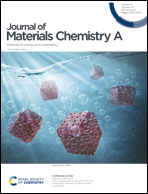Direct synthesis of 1T-phase MoS2 nanosheets with abundant sulfur-vacancies through (CH3)4N+ cation-intercalation for the hydrogen evolution reaction†
Abstract
1T-phase molybdenum disulphide (MoS2) is considered to be one of the most promising candidates to substitute noble metals in the hydrogen evolution reaction (HER). Fabricating single layer 1T-phase MoS2 with abundant sulfur vacancies as well as good stability to further enhance catalytic performance remains a challenge. Herein, we develop an efficient in situ TMA cation ((CH3)4N+) intercalation method to produce 1T-phase MoS2. The obtained MoS2 nanosheets comprise about 81% 1T-phase and abundant sulfur vacancies (>12%), as verified by aberration-corrected high-angle annular dark field scanning transmission electron microscopy (AC-HAADF-STEM), X-ray photoelectron spectroscopy (XPS), X-ray absorption fine structure (XAFS), etc. In addition, the surface of as-prepared ST-MoS2 is negatively charged, making it very stable in aqueous solution. The as-prepared ST-MoS2 exhibits excellent electrochemical HER performance with a low over-potential and a small Tafel slope as well as superior cycling stability. Furthermore, it is an excellent co-catalyst when coupled with CdS nanowires to form a CdS/ST-MoS2 heterojunction photocatalyst for the HER under visible light irradiation. It achieves a maximum H2 production rate and apparent quantum efficiency (AQE) of approximately 1187 μmol mg−1 h−1 and 73.4%, respectively, which are significantly higher than those of reported CdS/MoS2 photocatalysts.



 Please wait while we load your content...
Please wait while we load your content...